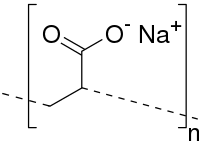
Photo from wikipedia
Photo-driven advanced oxidation process (AOP) with peracetic acid (PAA) has been poorly investigated in water and wastewater treatment so far. In the present work its possible use as tertiary treatment… Click to show full abstract
Photo-driven advanced oxidation process (AOP) with peracetic acid (PAA) has been poorly investigated in water and wastewater treatment so far. In the present work its possible use as tertiary treatment of urban wastewater to effectively minimize the release into the environment of contaminants of emerging concern (CECs) and antibiotic-resistant bacteria was investigated. Different initial PAA concentrations, two light sources (sunlight and UV-C) and two different water matrices (groundwater (GW) and wastewater (WW)) were studied. Low PAA doses were found to be effective in the inactivation of antibiotic resistant Escherichia coli (AR E. coli) in GW, with the UV-C process being faster (limit of detection (LOD) achieved for a cumulative energy (QUV) of 0.3 kJL-1 with 0.2 mg PAA L-1) than solar driven one (LOD achieved at QUV = 4.4 kJL-1 with 0.2 mg PAA L-1). Really fast inactivation rates of indigenous AR E. coli were also observed in WW. Higher QUV and PAA initial doses were necessary to effectively remove the three target CECs (carbamazepine (CBZ), diclofenac and sulfamethoxazole), with CBZ being the more refractory one. In conclusion, photo-driven AOP with PAA can be effectively used as tertiary treatment of urban wastewater but initial PAA dose should be optimized to find the best compromise between target bacteria inactivation and CECs removal as well as to prevent scavenging effect of PAA on hydroxyl radicals because of high PAA concentration.
Journal Title: Water research
Year Published: 2019
Link to full text (if available)
Share on Social Media: Sign Up to like & get
recommendations!